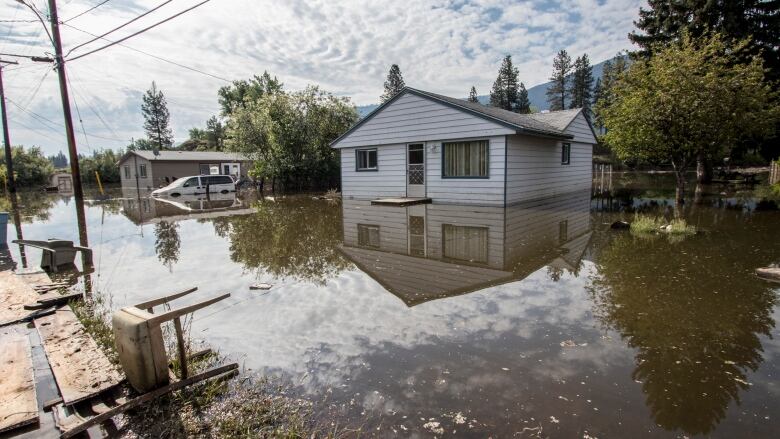Locals get first glimpse at swamped homes in Grand Forks, B.C.
An evacuation order for the Ruckle area went into effect on May 10

After a week away from their homes, residents in Grand Forks'Ruckle neighbourhood were allowed back in briefly Thursday and what they saw shocked them.
Ruckle, just off downtown Grand Forks, is one of the city's hardest hit areas. A combination of river water and sewage swamped the suburb of over 100 homes.
"It's great to be able to get in. It's a long time.You're anxious," said Anne Byers, who hadn't been home since Thursday.
"It's messy, scary.There is still water floating.There are piles of crap all over the place, and it's starting to stink," she said.
Residents were given a 12-hour period to collect valuables and lay down more sandbags.
Since 7 a.m. PT, a constant stream of vehicles moved through checkpoints set up by the RCMP and managed by volunteers.

Another surge expected
Residents brought truckloads of sand in preparation for the next surge that's expected in the coming days.
"It was crushing to not be able to come down and not to be able to help out," said Sharon St. Onge, who spent hours helping sandbag in the heat.
"This is where we live, and we want to try to save it."
Many homes were deluged with waist deep water tainted by raw sewage.
"It's a rude awakening how bad things are inside the house," said Jessica Thomas, who hadn't been home for eight days.
"It's the smell. It's not even the smell of septic. It's just rotting food and mould that there is after eight days of 30-degree weather and rain," she said.

"Our fridge is on its back. There is mud on the walls, mud on the floor, doors of cupboards are swollen shut from how much water they've absorbed."
Thomasand her boyfriend managed to take a few items out of the severely damaged home. Including their bicycles and sentimental items, such as a ball glove belonging to her boyfriend's late father.
For the latest on the flooding situation:
- Check theB.C. River Forecast Centre predictions
- Check flood warnings and advisories
- Check evacuation alerts and warnings
- Check road closures
'I can't get anything I need'
Others like Valerie Lafraniere aren't so lucky. Her home is swamped deep in wastewater, and the door won't open.
"I can't get anything I need. I left with the shirt on my back and these [clothes] are borrowed," she said.
"I got no job, I got no home.My car is gone," she said.
Many of the homes will likely never be lived in again; properties are soaked with water and sewage or reeking from it.
The emergency operation centre's rapid damage assessors will visit the homes and determine within half an hour whether the homes are salvageable.
Frances Maika with the emergency operation centre says they'll use a colour coding system which will determine if people can move back in.

"The average time it takes these assessors to do the rapid damage assessment is 30 minutes. It's hitting each of these homes in 30 minutes and putting them in categories of red, yellow or green," said Maika.
About 50 people are being trained to do the assessments.The expectation is they will be ready to do them by Saturday.
There areup to 600 homes and businesses in the Kootenay-Boundary region to be colour coded.













_(720p).jpg)


 OFFICIAL HD MUSIC VIDEO.jpg)
.jpg)



























































































